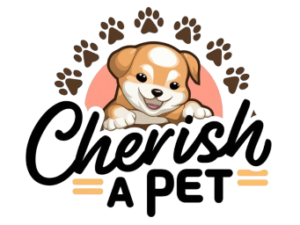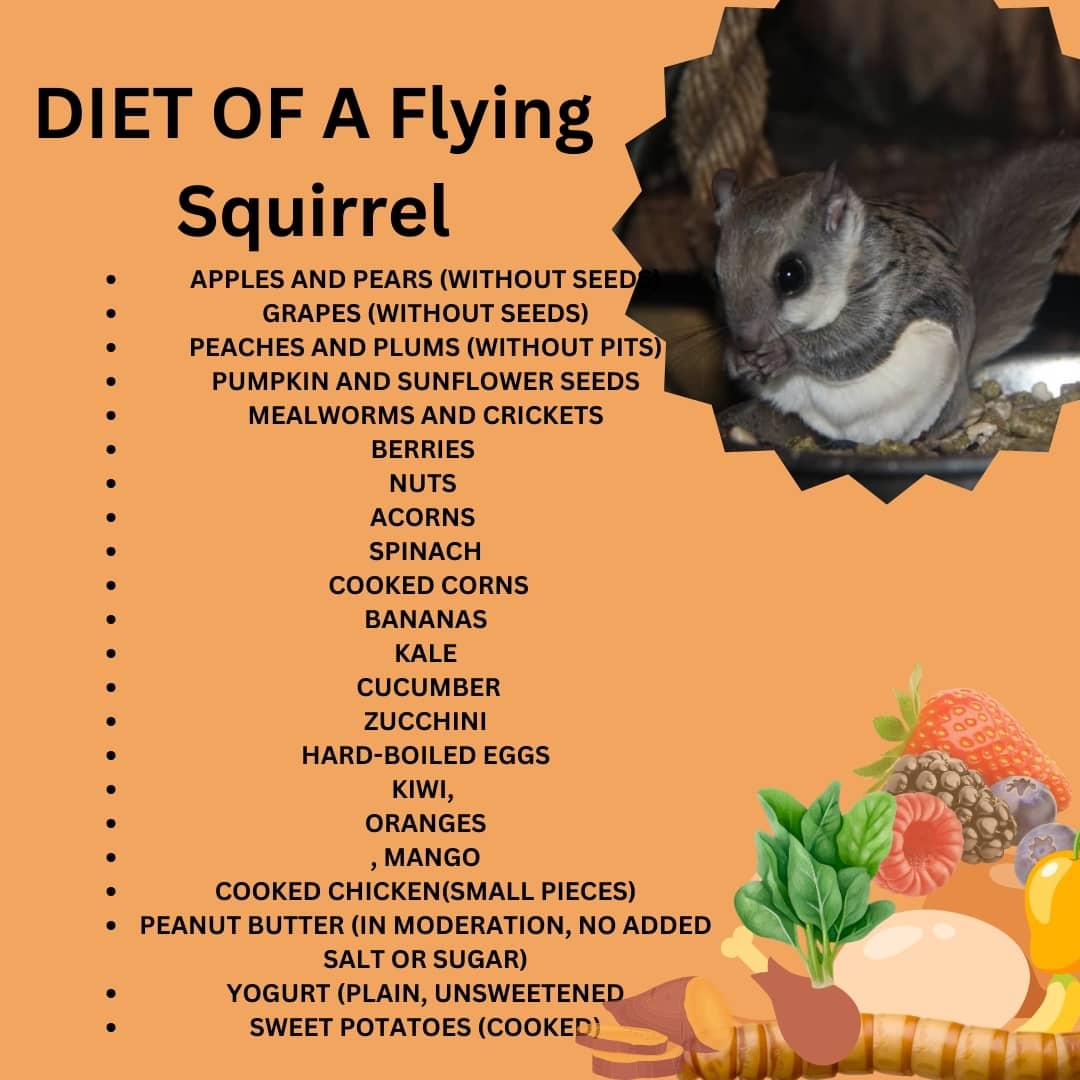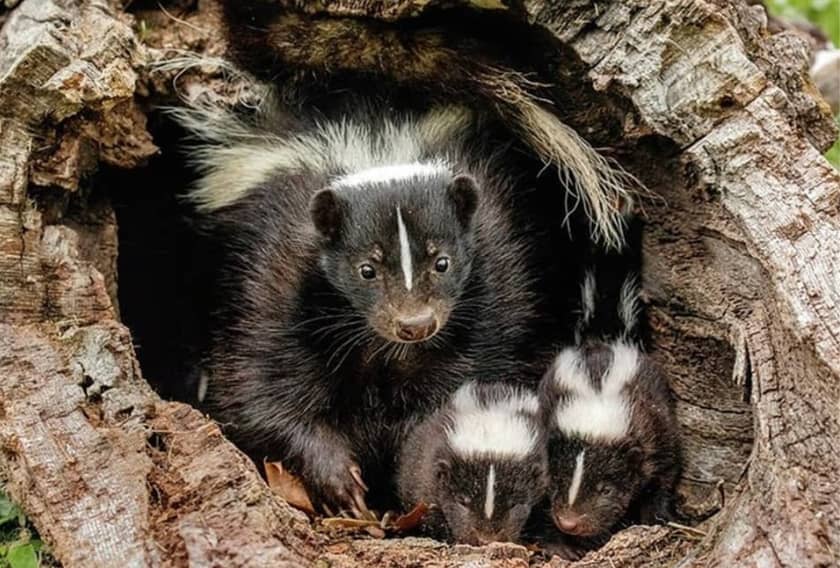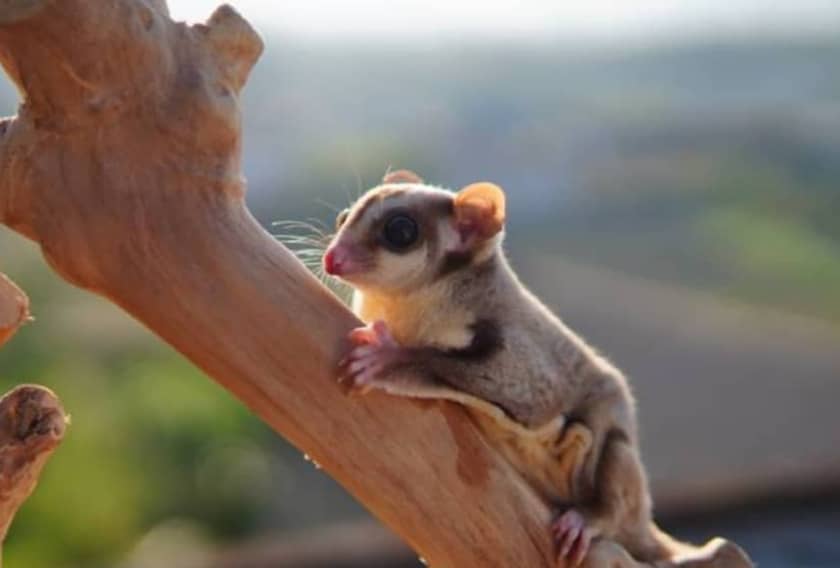Flying squirrel’s diet should be well-balanced, which gives them optimum nutrition for their growth. Their dietary requirements vary depending on their species and habitats. They are omnivorous animals that can feed on both animals and plants. The requirement of the flying squirrel for food can be between 10 and 30 grams of food per day. Flying squirrels are small, nocturnal mammals belonging to the family Sciuridae.
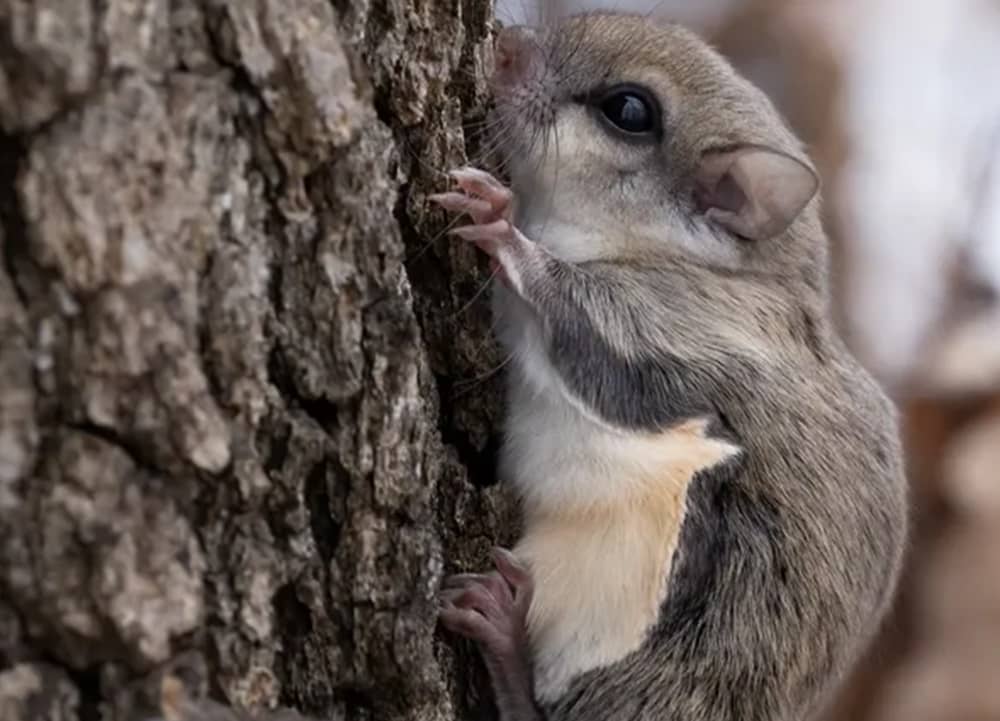
Flying Squirrel’s primary diets are ‘Herbivore’ (feeds on plants like fruits, plants, nuts, etc.), ‘Granivore’ (type of herbivore and feeds on seeds and grains), ‘Mycophage’ (feeds on fungi like mushrooms and other fungal growths), and ‘Carnivore’ (feeds on animals like bird eggs and insects). Their favorite foods are nuts, blackberries, and pieces of tree bark.
Flying Squirrel feeding areas are mostly in young or old forests. After hunting, they store or cache their food in the tree holes. In summer, autumn, and spring, they prefer fresh fungi, whereas in winter, they prefer lichens.
Northern Flying Squirrel Diet
A northern flying squirrel (Glaucomys sabrinus) is an omnivorous creature with a diverse diet according to their habitat. They require a balanced intake of nutrients to maintain their health.
Northern flying squirrels eat a variety of nuts, buds, and berries, except walnuts, as their shells are too hard to chew. They also consume stolen bird eggs, insects, etc. They also need some calcium and vitamins in their diet. For protein, you can feed hard-boiled eggs and chicken.

To fulfill vitamin requirements, you can offer fruits and some fresh vegetables for vitamin A, berries for vitamin C, foods like mushrooms, and vitamin D3 supplements can also offer vitamin D. These vitamins support their immune system and improve their eyesight. They save their food for the time they do not have food, and they store it in the holes of the trees.
Southern Flying Squirrel Diet
A southern flying squirrel (Glaucomys volans) is a small, nocturnal omnivore with a varied diet that builds their health. In the wild, they eat seeds, insects, and nuts.
In captivity, they eat bird seeds, nuts, fruits, mealworms, and fresh veggies. For protein-rich food, they can eat chicken or hard-boiled eggs. You may offer them calcium-rich foods such as kale, collard greens, and broccoli. They are vulnerable to calcium deficiency, so give them a calcium and vitamin D3 supplement with their food.

Avoid giving prepackaged or prepared foods, as they can not meet their full nutrition requirements.
Other Special Requirements
Flying squirrels are delightful creatures with diverse diets. They also need to fulfill their nutritional needs and other rodent requirements. To keep these rodents happy, it is essential to understand their needs and how to meet them.
Vitamin-rich Foods:
Flying squirrels need vitamins for their health, especially vitamin D. It stimulates the intake of calcium and bone health. Vitamin D is a natural nutrient that can be gained in the wild from sunlight or other fungi, such as truffles, but mushrooms are essential in captivity.
Calcium:
The cause of your squirrels’ MBD (metabolic bone disease) is inadequate calcium absorption. Some calcium-rich foods in captivity are green leafy veggies like spinach, broccoli, kale, calcium powder, yogurt, Fox Valley formula, cleaned beef bones, calcium cereals, and egg shells. In the wild, bird eggs, or deer antlers. Calcium helps in strong and healthy bones and teeth.
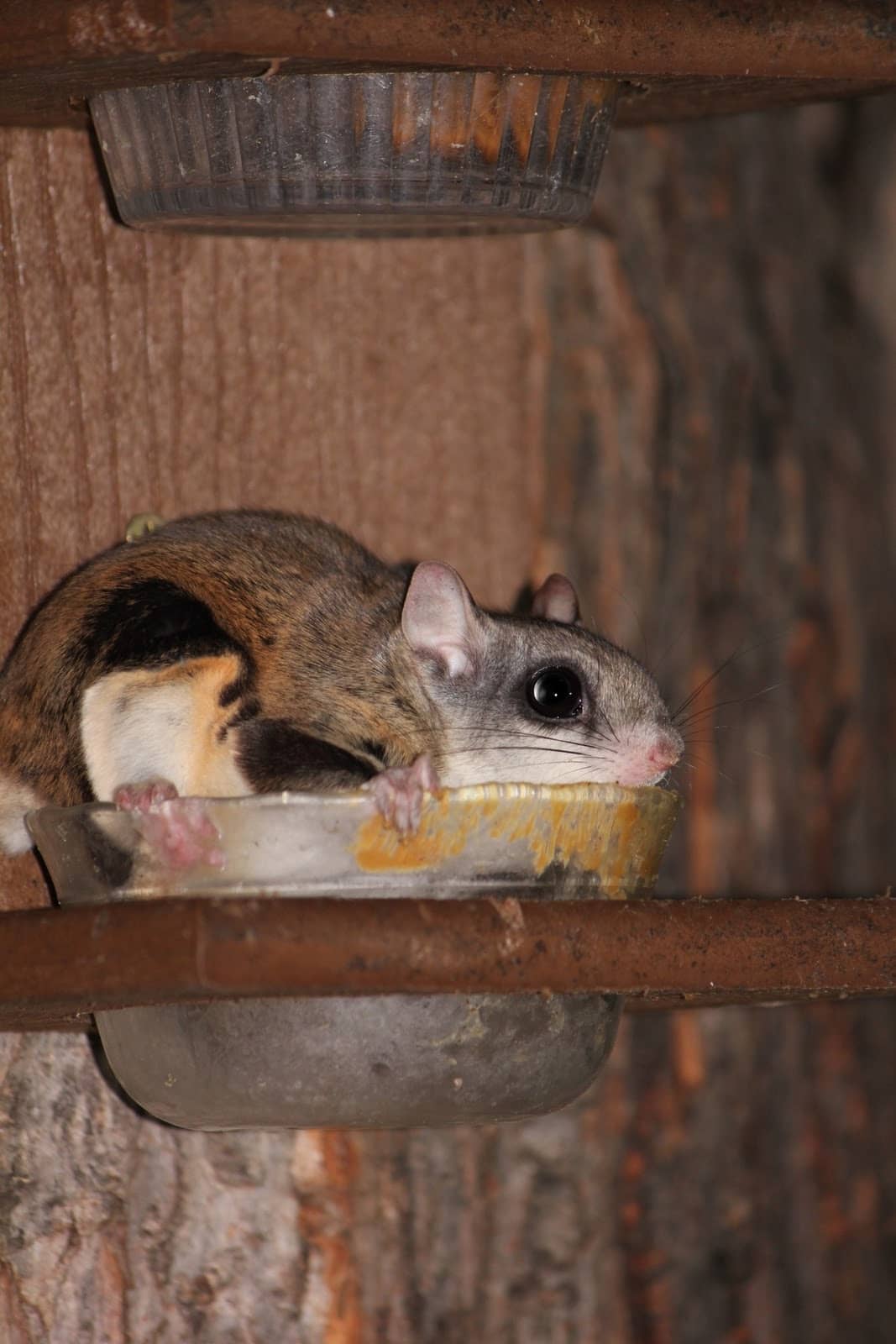
Protein:
Protein in your flying squirrel’s diet helps in muscle development. In the wild, they consume cicadas, crickets, grasshoppers, moths, and grubs. In captivity, you can offer insects, mealworms, and waxworms, which are easily available in pet stores. Also, some freeze-dried crickets, hard-boiled eggs, and chicken can be given to your flying squirrels.
Commercial Diets:
As natural foods are important, commercial diets ensure all necessary nutrients. Example: Henry’s Healthy Pet Block. It is designed for their nocturnal needs and a mix of essential vitamins, minerals, and other nutrients. The blocks are made with high-quality ingredients that provide protein, healthy fats, and necessary vitamins, making them a perfect balanced diet for your flying squirrels. You can complement it with some fruits and fresh veggies.
This commercial diet is very convenient for pet owners, as you can feed your squirrel easily with all the nutrients that they need to stay healthy and active.
Trees:
Because of your squirrel’s nocturnal behavior, you can offer them some branches. As they are excellent chewers, provide them with clean, untreated- pesticide branches to make their teeth stronger.
Along with that, they consume sap (rich in sugars and minerals), lichens (a source of vitamins and minerals), flowers (packed with nutrients and vitamins), and buds and fruits (vitamins and minerals).
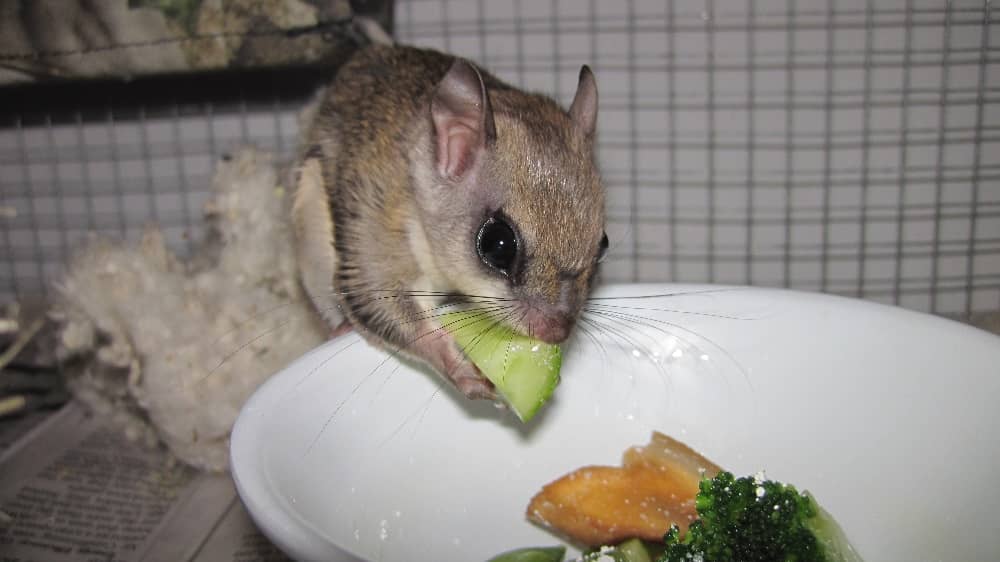
Treats:
After giving a proper, balanced diet to your squirrels, you can also give some traits to them to make them happy, like almonds, chestnuts, black walnuts, dried fruit flax seed, hazelnuts (filberts), pumpkin seeds, pine and soy nuts, sesame seeds, and oats (raw, dry, unsweetened, unflavored). This can improve the bond between your squirrel and you.
List of Some Safe Foods to Add to the Flying Squirrel Diet
| Apples and pears (without seeds) | Grapes (without seeds) | Peaches and plums (without pits) | Pumpkin and sunflower seeds | Mealworms and crickets |
| Berries | Nuts | Acorns | Spinach | Cooked corns |
| Bananas | Kale | Cucumber | Zucchini | Hard-boiled eggs |
| Kiwi, oranges, mango | Cooked chicken (small pieces) | Peanut butter (in moderation, no added salt or sugar) | Yogurt (plain, unsweetened) | Sweet potatoes (cooked) |
List of Some Safe Plants and Trees for Flying Squirrels
| Oak trees (acorns) | Pine trees | Elm trees | Ash trees |
| Maple trees | Dogwood trees | Fig | Hickory trees |
| Apple, pear, cherry, plum, and peach (only leaves and fruits) | Mulberry | Hazel trees | Berries bushes |
| Dandelion plants | Clover bushes | Honeysuckle bushes |
Points to Remember:
- Food should be fresh and free from pesticides and chemicals.
- Remove seeds, pits, and stones from fruits before offering them to your flying squirrels.
- For plants and trees, make sure they are safe and free from harmful chemicals and treatments.
- Avoid giving prepackaged foods to your flying squirrels.
Flying Squirrel’s Diets Are Not the Same as Sugar Gliders’
Sugar Gliders (Petaurus breviceps) are marsupials, not related to flying squirrels. Sugar gliders have unique dietary requirements according to their biology that include nectar, fruits, insects, and specially formulated glider foods that provide the exact balance of nutrients they need. Their diet is high in calcium and low in phosphorus, reflecting their natural diet in the wild.
On the other hand, Flying Squirrels are rodents, and their dietary needs differ from those of sugar gliders. Flying squirrels require a varied diet that includes nuts, seeds, fruits, vegetables, fungi, and insects. They also benefit from specific supplements, such as calcium powder and vitamin D, to support their bone health and well-being.
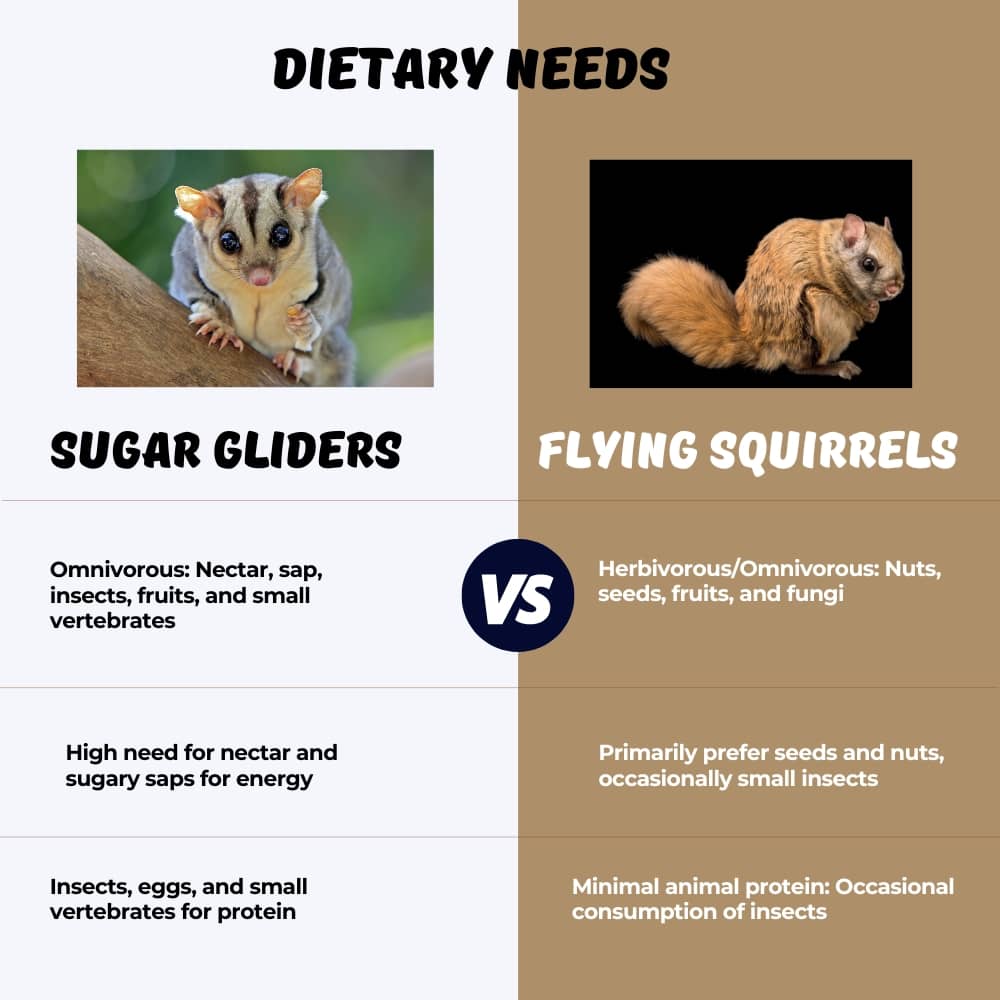
One thing you need to make sure of is that you never feed your flying squirrels commercial diets that are designed for sugar gliders, as they have different nutritional needs according to sugar gliders and do not meet the needs of flying squirrels.
Frequently Asked Questions
Question 1: How often should I feed my flying squirrel?
Answer: Flying squirrels should be fed daily with a balanced diet that includes a mix of commercial food, fresh fruits, vegetables, nuts, and insects. Treats should be given sparingly.
Question 2: What will happen if I feed a commercial diet of sugar glider to my flying squirrel?
Answer: Feeding a flying squirrel a sugar glider diet can lead to serious health issues, including malnutrition and bone disorders, due to imbalances in nutrients.
Question 3: What should I avoid feeding my flying squirrel?
Answer: Avoid feeding your flying squirrel foods that are high in sugar, processed foods, or diets intended for other animals like sugar gliders. Also, steer clear of toxic foods like chocolate and caffeine.
Question 4: Can flying squirrels eat human food?
Answer: Generally, human food is not recommended for flying squirrels, as it can be high in salt, sugar, and unhealthy fats. Stick to foods that are natural and safe for flying squirrels, avoiding processed or seasoned items.
Question 5: How do I introduce new foods to my flying squirrel’s diet?
Answer: Introduce new foods gradually by offering small amounts alongside familiar foods. Monitor how they react to the new food and increase the portion size if they enjoy it without any side effects.
Conclusion
Flying squirrels require a balanced and nutritious diet to maintain their health, strength, and overall wellness. These small, nocturnal creatures survive on a varied diet that includes fruits, nuts, seeds, insects, and vegetables, as well as essential elements such as calcium and vitamin D.
Flying squirrels may have a healthy life in the wild or captivity if they are fed a diet that is similar to their native habitat and is rich in safe plants and trees. Understanding their nutritional requirements not only benefits their physical health but also improves their natural behaviors and lifespan. You can join forums where you get details about the species’ requirements for proper nutrition and care. Flying squirrels may continue to glide freely in their surroundings, full of energy and life.
